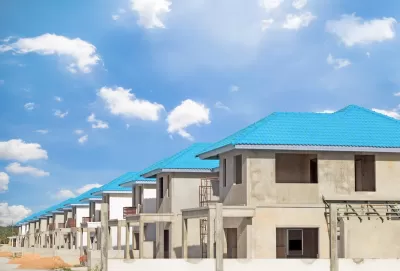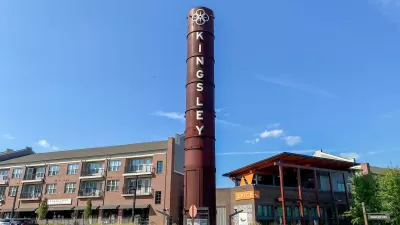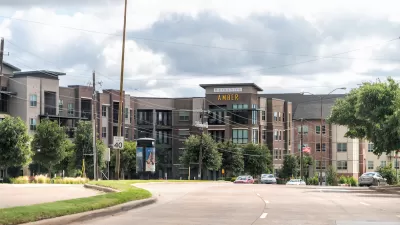How thoughtful design can create more walkable, livable communities.

The United Kingdom’s recently installed Labour Government has committed to facilitating the construction of 370,000 homes per year, announcing recently a Task Force that will develop detailed plans for “new towns” where much of that housing will take place.
Why build 370,000 homes? Ostensibly to drastically increase supply to better match housing demand. With a 2018 population of 66 million, the UK has seen steady population growth and has since added almost 4 million people. Demographers are projecting these trends to continue in the coming decade. Since 2018, only 850,000 homes have been built — not a fast enough pace to keep up with demand and sending housing prices soaring.
Infill development, building new housing units in built-up areas or increasing density, can only take the UK so far. Finding large sites outside urbanized areas where a real estate developer can build large projects of hundreds or thousands of homes may be the only way that the UK can achieve its goal, hence the new towns initiative.
Herein lies the rub: there is a difference between a master planned large housing development and a new town. New towns are an opportunity to create more than just homes but actual communities where people will thrive and that will endure for generations. My own research has shown that new towns that have vernacular architectural aesthetics, dense urban qualities, a mixed-use center, parks and public amenities, and a transportation network that prioritizes pedestrians, bikes, and transit will have a myriad of benefits for residents and foster greater engagement and well-being.
If the question is “How can we house millions of people currently living in substandard and overcrowded homes and accommodate even more residents in the future?” then new towns are the answer. And not just for the United Kingdom.
Here in the United States, we struggle with the same astounding housing prices and supply/demand mismatch in many metropolitan areas (a recent story about affordable housing woes in a remote rural part of America is particularly compelling). Likewise, housing construction has not kept up with population growth nationally, and increasing supply is often seen as critical. But how? There’s not much of an appetite for new towns in most of the U.S., and the large investments in transportation, sewer, water, electricity, and broadband required mean that such big projects are rare outside the Sunbelt. But in states like Massachusetts (population 7 million, area 10,500 square miles), our population density is only 666 persons per square mile (in comparison, the UK’s population density is 738 persons per square mile). Here in the Bay State, we have plenty of room for new towns, particularly ones located outside the existing metro areas of Boston, Worcester, and Springfield.
Using overlay districts to overcome zoning barriers
The biggest barrier to new town building in relatively dense states like Massachusetts is zoning, which prioritizes single-family detached homes. What is needed is for local governments to create by-right “new town” zoning overlays. The regulations might require a minimum parcel size of say 1,000 acres and stipulate a number of requirements for the new town developer: 1) water and sewer infrastructure, 2) pedestrian and bike paths, roadways, and connections with transit networks outside the town, 3) utilities, 4) schools, security, and other public facilities, 5) land use requirements like a town center and minimum density levels. But beyond that, let the developers have the flexibility to build these new towns and accelerate new housing construction. Dissenters might worry about the loss of farmland or forest space or the environmental impacts of such massive projects. All perfectly legitimate concerns that can be addressed in framing these overlay zoning ordinances: these new towns can be built responsibly. The problem is that if communities reject this kind of new town proactive planning approach, they will get scattershot developments that leapfrog all over a community and create a whole new generation of automobile dependency.
As the entire United States faces immigration pressures and the linked pressure of housing affordability, new towns offer a path for drastically increasing supply, while also creating places that foster high-quality living, access to community resources, walkable and healthier neighborhoods, and reliable public transit. These new towns will be relatively expensive places to live when they are first built because they will be new, so don’t expect them to be cheap — but they will take pricing pressure off of the older stock of homes across the country.
While the post-war suburban American landscape is typified by sprawling, single-use housing developments that are car-centric, this new generation of towns can be built with the pedestrian in mind and support car-free lifestyles that make us healthier and happier.
Justin B. Hollander, PhD, FAICP, is a professor in the Department of Urban and Environmental Policy and Planning at Tufts University and the author, most recently of Buildings for People: Responsible Real Estate Development and Planning (with Nicole Stephens).

Manufactured Crisis: Losing the Nation’s Largest Source of Unsubsidized Affordable Housing
Manufactured housing communities have long been an affordable housing option for millions of people living in the U.S., but that affordability is disappearing rapidly. How did we get here?

Americans May Be Stuck — But Why?
Americans are moving a lot less than they once did, and that is a problem. While Yoni Applebaum, in his highly-publicized article Stuck, gets the reasons badly wrong, it's still important to ask: why are we moving so much less than before?

Research Shows More Roads = More Driving
A national study shows, once again, that increasing road supply induces additional vehicle travel, particularly over the long run.

Judge Halts Enforcement of Anti-Homeless Laws in Grants Pass
The Oregon city will be barred from enforcing two ordinances that prosecute unhoused residents until it increases capacity and accessibility at designated camping sites.

Advancing Sustainability in Los Angeles County Schools
The Los Angeles County Office of Education’s Green Schools Symposium brings together educators, students, and experts to advance sustainability in schools through innovative design, climate resilience strategies, and collaborative learning.

Using Old Oil and Gas Wells for Green Energy Storage
Penn State researchers have found that repurposing abandoned oil and gas wells for geothermal-assisted compressed-air energy storage can boost efficiency, reduce environmental risks, and support clean energy and job transitions.
Urban Design for Planners 1: Software Tools
This six-course series explores essential urban design concepts using open source software and equips planners with the tools they need to participate fully in the urban design process.
Planning for Universal Design
Learn the tools for implementing Universal Design in planning regulations.
City of Moreno Valley
Institute for Housing and Urban Development Studies (IHS)
City of Grandview
Harvard GSD Executive Education
NYU Wagner Graduate School of Public Service
City of Cambridge, Maryland
Newport County Development Council: Connect Greater Newport





























